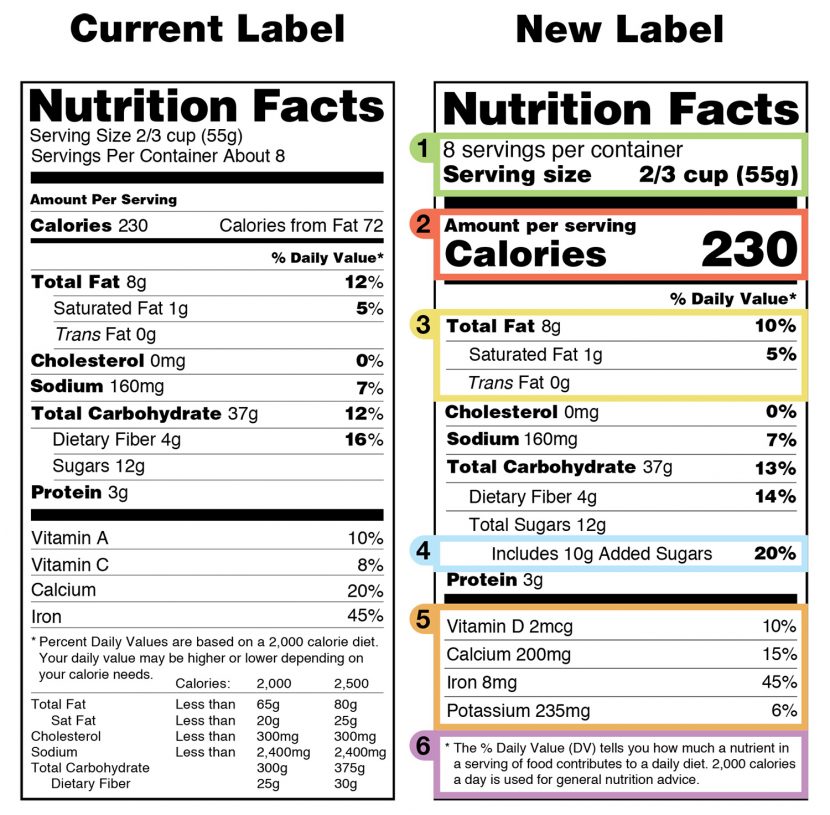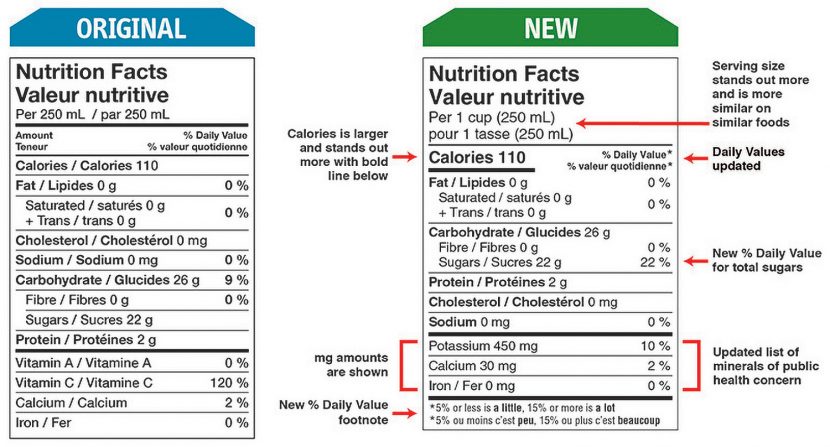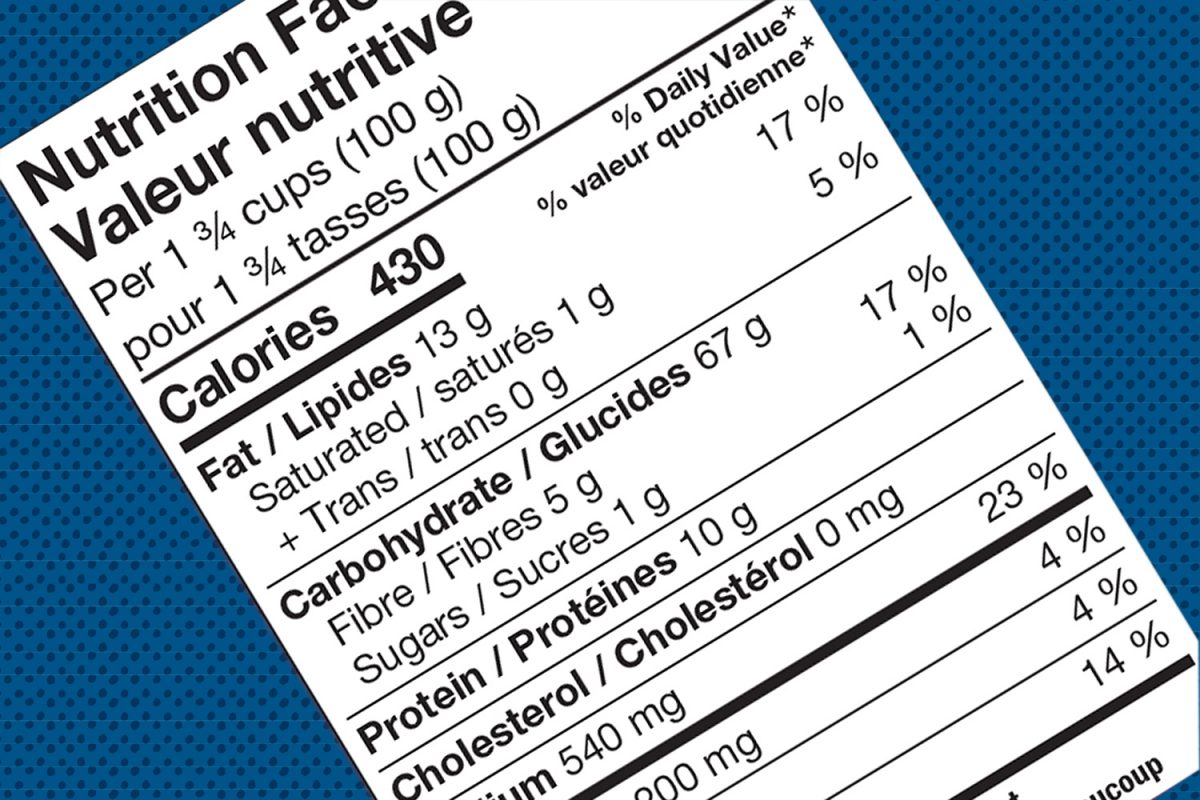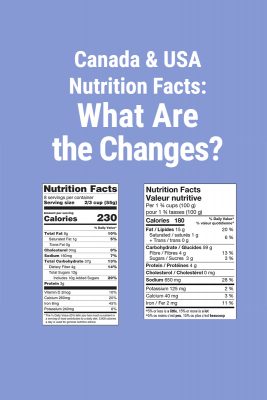In 2016, both the USA and Canada made changes to their Food Labeling regulations. This article covers them in detail.
On May 27, 2016, the FDA published new rules on Nutrition Facts labels for packaged foods. The deadline to change the Nutrition Facts tables are respectively January 1, 2020, for manufacturers with $10 million or more in annual sales; January 1, 2021, for those with less than $10 million and July 1, 2021, for manufacturers of single-ingredient sugars such as honey and maple syrup and certain cranberry products.
On December 14, 2016, the Canadian Food Inspection Agency also published changes to Canadian Nutrition Facts tables and to the list of ingredients for packaged foods. Manufacturers have five years from that date to change their food labels.
If most of the changes relate to the items and format of the Nutrition Facts tables themselves, note that the references for daily values used in the calculation of the “% Daily Value” (%DV) have also been changed (increased or decreased, depending on the nutrients). Examples include potassium DV, raised from 3,500 to 4,700 mg, sodium decreased from 2,400 to 2,300 mg, and total fat. And even though those reference daily values are often the same for both countries, caution should be exercised as there are some differences (e.g., fat). Approximately 30 out of 158 Reference Amounts Customarily Consumed (RACCs), used to calculate serving sizes, have also been revised, and 25 have been added. Few articles mention these changes.
For Canada, there are also some changes to the formatting of the ingredients list.
An upcoming article will review the differences between the U.S. and Canada in terms of labels and Nutrition Facts Tables for packaged foods. This article highlights the 2016 regulatory changes in the Nutrition Facts tables for two countries.
Changes to USA Food Label (FDA): Nutrition Facts Table

- Serving Size (1): The serving size mention is of a larger and bolder font. Some serving sizes have been actualized to reflect what people eat and drink (e.g., ice cream has increased from ½ cup to 2/3 cup) (See RACCs.). For certain products that are larger than a single serving but that we eat in one or multiple sittings (e.g., soda or ice cream), containing 200-300% of the RACC, both per serving and per container nutritional information is required (dual column packaging).
- Calories (2): The calories mention is of a larger and bolder font.
- Fats (3): “Calories from fat” has been removed. The daily value for total fat is increased from 65 to 78g.
- Dietary Fiber: The definition of dietary fiber is revised.
- Sugars (4): “Sugars” was changed to “Total Sugars” and “Includes Added Sugars” has been added. Added sugars must be expressed in grams and % Daily Value. And 50 g is the Daily Value for “Added Sugars.”
- % Daily Values: Reference daily values for some required nutrients and macro-nutrients have also been revised:
| For Adults | Old Daily Value | New Daily Value |
|---|---|---|
| Total fat | 65 g | 78 g |
| Total carbohydrate | 300 g | 275 g |
| Dietary fiber | 25 g | 28 g |
| Sodium | 2,400 mg | 2,300 mg |
| Potassium | 3,500 mg | 4,700 mg |
| Calcium | 1,000 mg | 1,300 mg |
| Vitamin D | 10 mcg | 20 mcg |
- List of Nutrients (5): Vitamin D and potassium are now required, whereas Vitamins A and C are no longer required. The amount of nutrients must be declared in mg or mcg, in addition to the % DV.
- Footnote (6): The wording of the footnote has changed to explain better what the percentage of daily values mean. The new text says: “The % Daily Value (DV) tells you how much a nutrient in a serving of food contributes to a daily diet. 2,000 calories a day is used for general nutrition advice.”
Changes to the Canadian Food Label: Nutrition Facts Table

- Serving Size: The font size for the serving size mention is larger. Regulated reference amounts (RA) are used to define serving sizes and to allow for more consistent serving sizes among similar products. The units of measure used to express the serving size (e.g., number of cookies, grams, etc.) are also defined by the same tables “Table of Reference Amounts for Food.”
- Calories: The calories mention is of a larger font, and a bold line appears below that mention.
- Sugars: A daily value for sugars has been defined (100 g), and the % Daily Value for total sugars was added.
- % Daily Values: Reference daily values for some required nutrients and macro-nutrients have been changed:
| For Adults | Old Daily Value | New Daily Value |
|---|---|---|
| Total fat | 65 g | 75 g |
| Fibres (Canadian spelling) | 25 g | 28 g |
| Sodium | 2,400 mg | 2,300 mg |
| Potassium | 3,500 mg | 4,700 mg |
| Calcium | 1,100 mg | 1,300 mg |
| Iron | 14 mcg | 18 mcg |
- List of Nutrients: The inclusion of potassium is now required, whereas Vitamins A and C are no longer required. The amount of nutrients must be declared in mg, in addition to the % DV.
- Footnote: The wording of the footnote has changed to better explain to consumers the relevance of the percentages listed. The new text says: “5% or less is a little, 15% or more is a lot.”
Changes to Canadian Food Label Ingredients List
- Appearance for “Ingredients”: The word “Ingredients” is in bold type. The individual ingredients are in black font, in upper and lower case letters, on a white or neutral background. There is a minimum type height required. Bullets or commas separate each ingredient.
- Sugars: Sugars are now grouped to help consumers understand how much sugar is added to the food (as the ingredients are listed in order of weight).
- Food colors: Colors are now listed by their common names
- Allergens, gluten sources, added sulphites (Canadian spelling): The same font style rules apply to this declaration. And the word “Contains” is in bold type.
For any question or comment, or if you require assistance for your bilingual Health Canada compliant food labels, please contact us. We’ve also written this article on the differences between Canadian and U.S. food labeling.
Glossary/Definitions:
- Serving Size: The amount of food or drink that generally consumed.
- Reference Amounts Customarily Consumed (RACCs): The “Reference Amounts Customarily Consumed” (RACC) is the amount of food and drink generally consumed. Defined by the FDA, they are used by food manufacturers to determine the serving size used in the Nutrition Facts Tables.
- Daily Values: Daily Values are the amounts of a nutrient that people should consume or not exceed in one day in their food intake. They are defined using the Dietary Reference Intakes (DRI) from the US Institute of Medicine.
- Dietary Reference Intakes (DRI): Dietary Reference Intakes are daily nutrient recommendations for healthy individuals, made by institutions such as the US Institute of Medicine. They are used by the FDA and Health Canada to define daily values used to calculate the % Daily Values on Nutrition Facts tables.
- % of Daily Value: On the Nutrition Facts table, the % of daily value is the amount of a nutrient that one serving size of that food contains, expressed as a % of the recommended amount of that nutrient which a healthy adult should consume in one day.
Need some field research for your food products? Need American or Canadian-compliant food labels, compliant with the new 2016 regulations? Feel free to contact us. We can help.
References used in this article:
FDA Food Labeling Regulations – USA Nutrition Facts Labels
- Final Rules to Update the Nutrition Facts Label – May 2016 (pdf)
- Changes to the Nutrition Facts Label – June 2018
- FDA – Food Labeling: Revision of the Nutrition and Supplement Facts Labels – Final Rule – July 2016 (RDIs p.903-904) (pdf)
Canada’s Food Labeling Regulations – Nutrition Facts Tables
• Food labeling changes
• Serving Sizes and Reference Amounts
• Canada’s New Food Labelling Regulations, an eBook From ESHA Research (download)
Want to pin this article?


